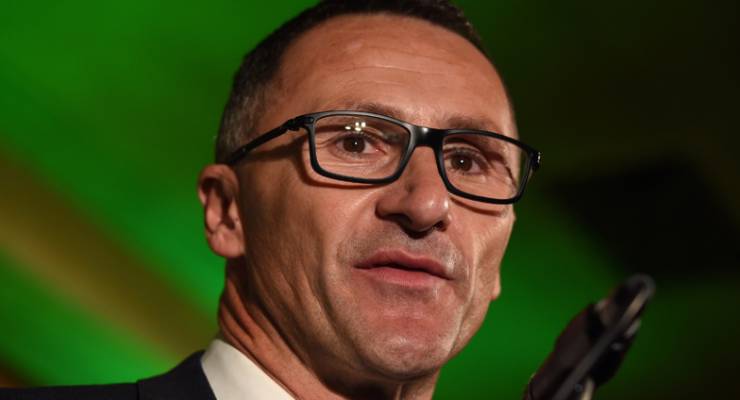
It’s never easy to compete with the cacophony of the majors duking it out in the parliament during budget week. Only the biggest of the lobby groups get a word in edgewise, leaving limited airtime for any other political players.
The oldest of the existing minor parties, the Greens, resorted to pulling a procedural stunt in the Senate to get its views into Hansard, and later broadcast its leader’s budget-in-reply speech to voters via Facebook. Neither rated much more than a mention in the media.
The media’s muted interest in the Greens’ budget position sits at odds with the party’s potential influence over the success or failure of this year’s budget. The Greens’ nine votes in the Senate, plus one other, is enough to pass any measure through the parliament.
Whether the left-wing party would be prepared to support such measures is another matter altogether. As has already been remarked upon by others, this is the most left-wing budget to be brought down by a right-wing government in Australia.
The Labor opposition may protest this is not a Labor budget, but there are elements of the Turnbull-Morrison economic statement that would be attractive to progressive voters. There’s more money for education and the National Disability Insurance Scheme (NDIS), an end to the freeze on Medicare rebates, and a big tax on banks.
But as the Greens’ leader and its other parliamentarians have pointed out, the budget hits a number of easy targets, including university students and welfare recipients. And there is no new money allocated to tackle climate change.
Faced with the Coalition’s unexpected lurch to the left, the Labor opposition has decided to shift even further in that direction, encroaching on what could be seen as the Greens’ traditional territory. This leaves the minor party with a challenging conundrum — should it join Labor in opposing most budget measures despite their merits, or differentiate from Labor by supporting or improving the government’s proposals?
Taking the latter, pragmatist path has been a defining characteristic of the Greens under its current leadership.
Now headed by urbane former GP, Richard Di Natale, the nominally protest party has surprised pundits and supporters in recent years by striking deals with the Coalition government. This has included removing the upper limit on the debt ceiling, scrapping group voting tickets for election to the Senate, establishing a 15% backpacker tax, and improving multinational tax avoidance laws.
This accords with the approach flagged by Di Natale when he was elected by his peers to replace retiring environmental warrior Christine Milne as leader of the party. Di Natale said at the time that the Greens was “the natural home of progressive mainstream Australian voters”
To make that statement a reality, the party is attempting to broaden its appeal beyond the traditional base of socialists, environmentalists and inner-city intelligentsia to include urban and suburban aspirationals, civic-minded seniors and young people. Adopting a more pragmatic approach to the passage of legislation appears to be part of that plan.
Whether the approach is working depends on the measure of success being used. This time last year, in an interview to mark his first year as Greens leader, Di Natale claimed the party’s membership had increased by one third.
A more transparent indicator of success would be the Greens’ support in the community, which appears to have levelled out — or decreased — according to Di Natale’s detractors in the New South Wales branch of the party.
At last year’s federal election, the Greens’ vote decreased by almost half a per cent in the Senate, but increased by almost two per cent in the lower house. This suggests the party is growing its support where it will have the most impact in a hung parliament, rather than trying to increase its overall national vote.
And as a result, the Greens are becoming increasingly competitive in a small number of urban and country House of Representatives seats, and could be a real threat to both Labor and Coalition MPs at the next federal election.
What does this mean for the federal budget? That will be determined by the issues that existing and potential Greens voters consider to be the most important.
Will those voters see Greens’ support for the bank levy as a smart revenue raiser, or enabling the Coalition’s evasion of a royal commission? Will they perceive support for the new Gonski arrangements as fair or an attack on aspirational families?
And will young voters accept the Greens helping the government to pass any element of the budget if, as Richard Di Natale argues, it “screws over” young Australians?
Given the Greens’ recent track record and pivotal role in the Senate, it’s fair to say that calls from Treasurer Scott Morrison for “the Parliament” to meet him in the middle on this “pragmatic” budget are as much an entreaty to the minor party as they are to Labor.
In fact, given the opposition’s tendency to adopt Abbott-lite positions, it could be said Morrison is specifically pleading for the Greens to help him out.
Unfortunately for the Greens, there is no easy way to identify the most politically sensible response to this request. Every option is fraught with political danger. Just ask the Democrats.








Continuing the fine media tradition of attempting to wedge Oz politics, and the Greens, into neat little pre-digested stereotyped ‘narrative’ boxes that have no real connection to reality.
I’m getting very weary of the myth of a thin line of differentiation in politics from right to left. First because there are so many possible issues and positions that determine the views of individuals, much less parties: take the combination of economics and social/sexual morality for example, where people who believe in unregulated markets are perfectly happy to see the state regulate social life of all, in fact they demand it. Second because assigning a label to a policy or budget prejudges the position being analysed as in this article. A move to the ‘left’ from the Abbott/ Hockey budget is a move to the centre of Australian thinking, not a ‘leftie’ move. There have been several days to think about this article and yet it sounds like little more than a top of the head throw away puff. Just stop it before Crikey itself loses credibility.
Really Crikey, if Paula Matthewson is the best you can come up with for commentary on the Greens, you need to try harder.
What leftie things, drug testing the destitute, making the poor pay for the rich? Come on Paula, your Howard connection shows with this con job.
Don’t forget the Greens support of changes to aged pension eligibility.
Why would that be problematic for the Greens? Limiting the pension to all but the most needy is totally consistent with their ideology.
Point being that it was another deal struck with the coalition that Paula didn’t mention, is all.